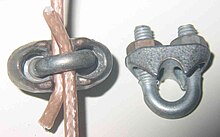Rope clamp
Rope clamps are screwable connections for ropes. They consist of a U-shaped bracket with threads at each end and a yoke that bridges the two ends of the bracket. Usually two pieces of rope or rods are inserted into the bracket and are to be connected to one another in a shear-proof manner. Two nuts turned on the ends of the bracket push the clamping saddle (also clamping jaws or yoke ) against the steel cables and clamp them in the bracket.
Rope clamps are mainly used to clamp steel cables and, in contrast to crimp sleeves or ferrules, can be opened for readjustment and also reused.
use
A frictional and positive fit in the rope clamp creates a non-positive connection.
Just like a knot , the rope clamp creates a notch effect in the rope, which reduces the load-bearing capacity ( minimum breaking force ) of the rope to 80%.
In order to keep the notch effect within a permissible range, rope clamps may only be tightened with a certain force. If a rope clamp is tightened to its load limit, this will damage the rope. In order to protect the rope and still achieve the greatest possible clamping effect, several rope clamps must always be used one behind the other. Depending on the rope diameter, 3 to 4 rope clamps are usually used one behind the other. However, like the intended tightening torque, this also depends on the type of clamp.
A rope eye is always carried out with a thimble . When using rope clamps to fix the rope to the thimble, the bracket of the rope clamp must always be at the loose end of the rope. The yoke is placed accordingly on the further, loaded end of the rope, since the wider clamping saddle has a lower notch effect on the rope than the bracket.
Rope clamps are only permitted on safety-relevant slings when using several rope clamps.
Rigging
Rope clamps are often used to create eyes in the standing rigging of sailing boats. The eyes are then attached to the hull with turnbuckles and fittings and are part of the rigging . Rope clips are faster and easier to use than splices . However, the load-bearing capacity of the connection with splice is superior.
safety
Wire rope clamps according to DIN EN 13411-5 may only be used for suspending static loads and not for mining hoist ropes or permanent fastening of ropes in hoists. Furthermore, wire rope clips may only be used as a component for a special one-time use of a sling and for one-time lifting operations.
Instead, lifting gear should be pressed with sleeves.
With such a loop, the jaws of the rope clamp must always sit on the load-bearing rope and the bracket on the short end. Use at least 4 rope clamps for thin ropes and up to six for thicker ropes. The clamps must always be tightened under load because the rope becomes thinner under load.
literature
- Roland Verreet: rope terminations . Engineering office for wire rope technology Wire Rope Technology Aachen GmbH (Ed.), Aachen 2012, p. 6.
- Martin Bechtold: The load-bearing behavior of detachable rope clamps on open and fully closed spiral ropes. Approved dissertation at the Faculty of Civil Engineering, Geo- and Environmental Sciences of the University of Fridericiana in Karlsruhe (TH), Karlsruhe 2005.
See also
Individual evidence
- ↑ a b c Original operating instructions Preifer wire rope clamp according to DIN EN 13411-5
- ↑ DIN EN 13411
Web links
- Assembly instructions rope clamps (accessed on July 16, 2020)
- Original operating instructions PFEIFER wire rope clamp (accessed on July 16, 2020)
- Rope tension calculation of the tensile load (accessed on July 16, 2020)
- DGUV Information 215-313 Loads over people p. 13 (accessed on July 16, 2020)

